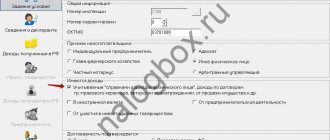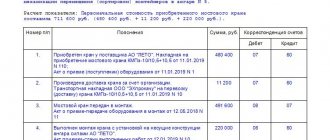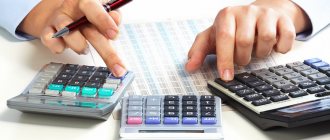All-Russian classifier of units of measurement
Every day, any organization produces a huge number of documents. Sometimes, in order to save time, space on a document and make it understandable for a large number of users, special codes are used.
Our country has developed a Unified Classification System, which includes many codes used in all spheres of the economy.
The classifier includes the following groups of units:
- Economic
- Technical
- Masses
- Volume
- Time
- Square
- Lengths
The classifier was approved by Gosstandart Decree No. 366 dated December 26, 1994 with the latest amendments and is associated with GOST 8.417-81 (as amended by Rosstandart Order No. 1101-st dated September 26, 2013.
All data contained in the classifier must be used by specialists in full accordance with it, without deviation.
If the required code is not in the generally accepted classifier, you can add your own values for use in a specific company, which are understandable to the counterparty. For example, the Classifier does not have such a unit of measurement as “Service”. Someone measures services in units, which is probably not very correct, someone adds such a name to their internal classifier. Many people simply put dashes in the corresponding columns of documents when providing services.
The codes contained in the classifier are also used in the preparation of annual financial statements. Let's take a closer look.
According to section 1 OK 015-94 (MK 002-9):
International units of economic units (SI) included in OKEI
| OKEY code | Unit name | Symbol | Code letter designation | ||
| national | international | national | international | ||
| 499 | kilogram per second | kg/s | — | KG/S | KGS |
| 533 | Ton of steam per hour | t steam/h | — | T STEAM/H | TSH |
| 596 | Cubic meter per second | m3/s | m3/s | M3/S | MQS |
| 598 | Cubic meter per hour | m3/h | m3/h | M3/H | MQH |
| 599 | Thousand cubic meters per day | 103 m3/day | — | THOUSAND M3/DAT | TQD |
| 616 | Spool | bean | — | BEAN | NBB |
| 625 | Sheet | l. | — | SHEET | LEF |
| 626 | One hundred sheets | 100 l. | — | 100 SHEET | CLF |
| 630 | Thousand standard conditional bricks | thousand std. conventional brick | — | THOUSAND STANDARD USL KIRP | M.B.E. |
| 641 | Dozen (12 pcs.) | dozen | Doz; 12 | DOZEN | DZN |
| 657 | Product | ed. | — | ISD | NAR |
| 683 | One hundred boxes | 100 boxes | Hbx | 100 BOX | HBX |
| 704 | Kit | kit | — | KIT | SET |
| 715 | Pair (2 pieces) | steam | pr; 2 | STEAM | NPR |
| 730 | Two tens | 20 | 20 | 2 DES | SCO |
| 732 | Ten pairs | 10 pairs | — | DES PAR | TPR |
| 733 | A dozen couples | a dozen pairs | — | A DOZEN PAIRS | DPR |
| 734 | Package | message | — | MESSAGE | NPL |
| 735 | Part | Part | — | PART | NPT |
| 736 | Roll | rul | — | RUL | NRL |
| 737 | A dozen rolls | a dozen rolls | — | A DOZEN RULS | DRL |
| 740 | A dozen pieces | a dozen pieces | — | A DOZEN PCS | DPC |
| 745 | Element | ale | Cl | ELEM | NCL |
| 778 | Package | pack | — | UPAK | NMP |
| 780 | A dozen packs | dozen pack | — | A DOZEN PACK | DZP |
| 781 | One hundred packs | 100 pack | — | 100 UPAK | CNP |
| 796 | Thing | PC | pc; | PC | PCE; |
| 1 | NMB | ||||
| 797 | One hundred pieces | 100 pieces | 100 | 100 PIECES | CEN |
| 798 | A thousand pieces | thousand pieces; | 1000 | THOUSAND PCS | MIL |
| 1000 pcs | |||||
| 799 | A million pieces | 106 pcs | 106 | MILLION PCS | MIO |
| 800 | Billion pieces | 109 pcs | 109 | BILLION PCS | MLD |
| 801 | Billion pieces (Europe); | 1012 pcs | 1012 | BILL ST (EUR); | BIL |
| trillion pieces | TRILL PIECE | ||||
| 802 | Quintillion pieces (Europe) | 1018 pcs | 1018 | QUINT PIECE | TRL |
| 820 | Alcohol strength by weight | crepe. alcohol by weight | % mds | CREPE ALCOHOL BY MASS | A.S.M. |
| 821 | Alcohol strength by volume | crepe. alcohol by volume | %vol | CREPE ALCOHOL BY VOLUME | ASV |
| 831 | Liter of pure (100%) alcohol | l 100% alcohol | — | L PURE ALCOHOL | LPA |
| 833 | Hectoliter of pure (100%) alcohol | hl 100% alcohol | — | GL PURE ALCOHOL | HPA |
| 841 | Kilogram of hydrogen peroxide | kg H2O2 | — | KG HYDROGEN PEROXIDE | — |
| 845 | Kilogram of 90% dry matter | kg 90% dry | — | KG 90 PERCENT DRY THINGS | KSD |
| 847 | Ton of 90% dry matter | t 90% dry | — | T 90 PERCENT DRY THINGS | TSD |
| 852 | Kilogram of potassium oxide | kg K2O | — | KG POTASSIUM OXIDE | KPO |
| 859 | Kilogram of potassium hydroxide | kg KOH | — | KG POTASSIUM HYDROXIDE | KPH |
| 861 | Kilogram of nitrogen | kg N | — | KG NITROGEN | KNI |
| 863 | Kilogram of sodium hydroxide | kg NaOH | — | KG SODIUM HYDROXIDE | KSH |
| 865 | Kilogram of phosphorus pentoxide | kg P2O5 | — | KG PHOSPHORUS PENTOXIDE | KPP |
| 867 | Kilogram of uranium | kg U | — | KG URAN | KUR |
What is the balance sheet of an organization
The balance sheet is one of the most important and sought-after documents of the company.
All information that is reflected in accounting during the year is ultimately consolidated into one document - the balance sheet of the organization. This is one of the integral (and most important) parts of the company’s entire annual reporting. .
Balance is required by many users. Among them:
- Owners of the company
- Banks
- Organization partners
Using the report indicators, you can assess the level of development of the company and, importantly, its financial condition.
The report is a tabular form consisting of two large parts - assets and liabilities. An asset reflects everything that an organization owns, and this is not only property, but also, for example, accounts receivable or financial investments of the company. The liability reflects all sources of the organization's assets, for example, such as various types of capital (mainly authorized capital) or the organization's accounts payable.
Of course, there must be mandatory equality between assets and liabilities. Otherwise, the report was compiled incorrectly and something was missed.
| ★ Best-selling book “Accounting from scratch” for dummies (understand how to do accounting in 72 hours) > 8,000 books purchased |
Review of the latest changes in taxes, contributions and wages
You have to restructure your work due to numerous amendments to the Tax Code. They affected all major taxes, including income tax, VAT and personal income tax.
Your colleagues are currently reading:
Subscribe to us on VKontakte
© 2011–2018 Aktion Accounting LLC
The Russian Tax Courier magazine is a specialized practical magazine for chief accountants, auditors and tax consultants
All rights reserved. Full or partial copying of any site materials is possible only with the written permission of the editors of the Russian Tax Courier magazine. Violation of copyright entails liability in accordance with the legislation of the Russian Federation.
This site is not a mass media outlet. As a printed media outlet, the Russian Tax Courier magazine is registered by the Federal Service for Supervision of Communications, Information Technologies and Mass Media (Roskomnadzor) Registration Certificate PI No. FS77-62249 dated 07/03/2015
Unit code 384 in balance sheet
According to paragraph 16 of PBU 4/99, the company’s annual reporting is prepared in Russian currency, that is, in rubles.
Depending on how large the balance sheet indicator is, it is more convenient to indicate the values of the indicators in rubles, thousands of rubles, millions of rubles and even billions (which is very rare). Each organization decides which units of measurement to use independently. .
Of course, the most often used unit of measurement is a thousand rubles, since organizations in which it is possible to keep records of indicators in millions are several times smaller.
| Code | Explanation of the name |
| 383 | Ruble |
| 384 | Thousand rubles |
| 385 | One million rubles |
Therefore, most organizations use balance sheet measurement code 384.
This code is entered in the “Units of Measurement” line. It looks like this:
As you can see, units of measurement are written in words, abbreviated as “thousands”. rub.”, and the code is placed in the corresponding cell of the form.
According to section 3 OK 015-94 (MK 002-9):
Four-digit national units of measurement of economic units included in the OKEI
| OKEY code | Unit name | Symbol (national) | Code letter designation (national) |
| 3831 | Ruble ton | rub. ton | RUB TON |
| 5401 | Children's day | det. days | DET DN |
| 5423 | person per year | person/year | PERSON/YEAR |
| 5451 | Visit | visiting | VISIT |
| 5562 | Thousand nests | 103 nests | THOUSAND NESTS |
| 6421 | Units per year | units/year | UNIT/YEAR |
| 6422 | Call | call | CALL |
| 6423 | Sowing unit | village units | POS. ED |
| 6424 | Strain | strain | STRAIN |
| 7923 | Subscriber | Subscriber | SUBSCRIBER |
| 8361 | Individual | OS | INDIVIDUAL |
| 8751 | Box | core | KOR |
| 9061 | Million hectares | 106 hectares | MILLION hectares |
| 9062 | Billion hectares | 109 hectares | BILLION HA |
| 9111 | Bed day | bed days | BED DN |
| 9113 | Patient-day | patient. days | PATIENT DN |
| 9245 | Record | recording | RECORD |
| 9246 | Document | document | DOCUMENT |
| 9491 | Imprint sheet | sheet. imprint | SHEET. IMPRESSION |
| 9501 | Car (car)-hour | vag (mash) h | VAG (MASH) H |
| 9557 | A million goals | 106 goal | MILLION GOAL |
| 9641 | Flight hour | summer h | LETN H |
| 9642 | Point | point | SCORE |
| 9802 | Million dollars | 106 dollar | MILLION DOLLAR |
| 9803 | Billion dollars | 109 dollar | BILLION DOLLAR |
| 9805 | Dollar per ton | dollar per ton | DOLLAR PER TON |
| 9910 | International unit of biological activity | ME | ME |
| 9911 | Thousand international units of biological activity | thousand IU | THOUSAND ME |
| 9912 | Million International Units of Biological Activity | million IU | MILLION ME |
| 9913 | International unit of biological activity per gram | IU/g | IU/G |
| 9914 | Thousand international units of biological activity per gram | thousand IU/g | THOUSAND IU/G |
| 9915 | Million international units of biological activity per gram | million IU/g | MILLION IU/G |
| 9916 | International unit of biological activity per milliliter | IU/ml | IU/ML |
| 9917 | Thousand international units of biological activity per milliliter | thousand IU/ml | THOUSAND IU/ML |
| 9918 | Million international units of biological activity per milliliter | million IU/ml | MILLION IU/ML |
| 9920 | Unit of action of biological activity | ED | ED |
| 9921 | Unit of action of biological activity per gram | U/g | U/G |
| 9922 | Thousand action units of biological activity per gram | thousand units/g | THOUSAND U/G |
| 9923 | Unit of action of biological activity per microliter | U/µl | U/SCL |
| 9924 | Unit of action of biological activity per milliliter | U/ml | U/ML |
| 9925 | One thousand biological activity units per milliliter | thousand units/ml | THOUSAND U/ML |
| 9926 | Million action units of biological activity per milliliter | million units/ml | MILLION U/ML |
| 9927 | Unit of action of biological activity per day | UNITS/day | UNIT/DAY |
| 9930 | Antitoxic unit | AE | AE |
| 9931 | One thousand antitoxic units | thousand AE | THOUSAND AE |
| 9940 | Antitrypsin unit | ATRE | ATRE |
| 9941 | One thousand antitrypsin units | thousand ATRE | THOUSAND ATRE |
| 9950 | Reactivity Index | IR | IR |
| 9951 | Reactivity index per milliliter | IR/ml | IR/ML |
| 9960 | Kilobecquerel per milliliter | kBq/ml | KILOBK/ML |
| 9961 | Megabecquerel per milliliter | MBq/ml | MEGABAK/ML |
| 9962 | Megabecquerel per square meter | MBq/m2 | MEGABK/M2 |
| 9970 | Kallikrein inhibitory unit per milliliter | KIE/ml | KIE/ML |
| 9971 | One thousand kallikrein inhibitory units per milliliter | thousand KIU/ml | THOUSAND KIE/ML |
| 9980 | Million colony forming units | million CFU | MILLION CFU |
| 9981 | Million colony forming units per packet | million CFU/package | MILLION CFU/PACK |
| 9982 | Billion colony forming units | billion CFU | BILLION. CFU |
| 9983 | Proteolytic unit | PE | PE |
| 9985 | Microgram per milliliter | mcg/ml | MCG/ML |
| 9986 | Microgram per day | mcg/day | MCG/SUT |
| 9987 | Micrograms per hour | mkg/h | MKG/H |
| 9988 | Micrograms per dose | mcg/dose | MCG/DOSE |
| 9990 | Millimoles per milliliter | mmol/ml | mmol/ml |
| 9991 | Millimoles per liter | mmol/l | mmol/L |
Requirements for the company's balance sheet
All the basic requirements for financial statements are enshrined in regulations:
- The first such act is the Law “On Accounting”. This is a fundamental document, which in article 13 sets out how reporting should be compiled
- Order of the Ministry of Finance No. 34n dated July 29, 1998, as amended in 2018. Articles 30 to 40 provide general information about the composition of the report
- PBU 4/99, paragraphs 6 to 17 reflect the reporting procedure
In addition to the standard design requirements, the following main ones can be noted:
| Requirement | Explanation |
| Reliability and completeness | Annual reports must be reliable and contain complete information about the company’s activities |
| Neutrality | Information in the forms should be neutral, that is, it should not influence the decisions or assessments of those individuals who are its users |
| Subsequence | The composition must be consistent. One form must be drawn up taking into account the indicators of the other |
| Comparability | Reporting indicators reflected for several periods must be comparable |
| Report period | The balance sheet is compiled as of December 31, other forms for the year as a whole |
Formulation of the problem
The receipt and sale of goods are reflected in the documents “Receipt invoice” and “Expense invoice”, respectively. These documents require the ability to specify the quantity of goods in different units of measurement. For example:
- in pieces
- in boxes containing 10 pieces
- boxes of 50 pieces.
The set of units of measurement for each item is individual and can contain an arbitrary number of units of measurement. For example, for one product:
- thing
- box of 10 pieces
- box of 30 pieces
- pallet of 20 boxes, i.e. of 200 pieces.
For other product:
- bottle
- box of 6 bottles
- box of 20 bottles.
When performing movements across registers, documents should automatically recalculate the quantity from the units of measurement selected in the document into the unit of storage of balances. For example, if the invoice indicates the sale of 3 boxes, then 30 pieces should be written off in the register movements (for this item, the unit for storing balances is a piece).
This subtask—converting the quantity from the unit of measurement specified in the document into the unit of storage of balances—is found in the following problems in the collection for preparing for the “1C: Platform Specialist” exam: 1.10, 1.15, 1.23.
Note that in the problems of the collection, units of measurement are taken into account only when selling, while in the problem considered they are taken into account both when selling and when receiving. This is done for educational purposes to demonstrate some approaches to building a configuration. The very principle of solving this problem is also suitable for solving the above-mentioned problems in the collection for preparing for the exam.
Planned changes in 2020 – 2020 in annual reporting
Changes to the rules for filing annual reports are planned in the near future.
First of all, it is worth noting that the obligation to submit reports to the statistics service has been canceled for the 2020 report. Now the balance sheet and all related reports are sent only to the tax office.
Starting from the 2020 report, reporting is prepared in thousands of rubles.
On the first sheet of the report the code of the type of activity is entered in accordance with OKVED 2.
From 2020, the form of the financial results report will change. Some lines will disappear and several new ones will appear.
In general, no fundamental changes are planned in the annual reporting.
Transport tax declaration and its codes
The transport tax declaration contains the following data: “Unit of measurement of the tax base according to OKEI,” which consists of 4 codes: 181,251,796 and 999. I don’t know which code a specific vehicle belongs to, and I can’t get through to the tax authorities. Please help me decipher these codes
The code is indicated depending on the units of measurement of the tax base.
For example, for cars the code is 251 - the base is measured in horsepower.
The rationale for this position is given below in the materials of the Glavbukh System
1. Recommendation: How to calculate transport tax
Payment method for fuel and lubricants
An organization can purchase fuel and lubricants for cash and in non-cash form.
For cash payment, fuel and lubricants are purchased by employees of the organization and settlements are carried out using account 71 “Settlements with accountable persons”.
An employee of an organization who has received funds for reporting, after purchasing fuels and lubricants, submits an advance report to the accounting department according to the unified form AO-1 “Advance report”, approved by Resolution of the State Statistics Committee of Russia dated January 1, 2001 No. 55. All supporting documents must be attached to the advance report documents confirming expenses incurred.
When receiving fuel and lubricants non-cash by using fuel cards (Oil Cards) or coupons, it is advisable to determine the procedure for their receipt, storage, issuance, as well as the financially responsible person by order of the manager. In addition, fuel and lubricants can be purchased using a corporate plastic bank card. One of the advantages of paying for fuel and lubricants using a bank card is the absence of a limited number of gas stations, which is present with fuel suppliers offering fuel cards or coupons. To confirm the fact of purchasing fuels and lubricants using a plastic bank card, the accountable person must submit a document confirming payment (payment terminal slip); cash register receipt (or receipt). To account for funds on a plastic bank card, account 55 “Special accounts in banks”, subaccount 4 “Bank cards” is opened. The cards themselves are accounted for in account 50 “Cashier”, subaccount 3 “Cash documents” at face value.
Coupons for the right to receive fuel
Coupons for the right to receive fuel should be issued to drivers only upon presentation of a waybill, on which a person determined by order of the head of the organization, in the “Issue” line, should indicate in words the amount of fuel allowed for issuance according to the coupons according to the assignment and taking into account the amount of gasoline in the tanks at leaving. The driver signs the coupon issuance record sheet, opened for each brand of fuel, for the coupons received. At the end of work, unused coupons are handed over to the financially responsible person, who makes the appropriate entries in the coupon return sheet.
There are the following types of coupons for fuel and lubricants:
— coupons with quantitative expressions, which indicate the brand and quantity of fuel (for example, “Gasoline AI-95, 50 liters”);
— coupons with quantitative and cost expressions, which record a certain amount of fuel and its price at the time of prepayment of coupons (for example, “50 liters, 33 rubles per 1 liter”);
- coupons with value terms, which indicate the brand, quantity and cost of fuel (for example, “Gasoline AI-95, 50 liters, 36 rubles per 1 liter”).
Coupons are taken into account either in account 10, sub-account 31 “Gasoline coupons”, or in off-balance sheet account 006 “Strict reporting forms” in the analytics by brands of fuels and lubricants and by financially responsible persons, or as monetary documents in account 50 “Cashier”, subaccount 3 “Cash documents”.
Fuel cards
Fuel cards contain information about the volume of purchased unused fuel at the moment and allow its holder to fill the fuel tank with gasoline within the consumption limit established by the contract.
Fuel cards can be limited or unlimited. On a limited fuel card, a single daily, weekly or monthly limit on the number of liters is established, that is, with this card the holder can fill the car with fuel, the total amount of which per day or over a period of time should not exceed the established limit, regardless of how many liters of fuel were received on map in the previous period of time. The amount of fuel paid is reduced by the amount of liters received. The number of liters of the required type of fuel purchased by the purchasing organization from the supplier is entered onto the unlimited fuel card. This amount can be received by the buyer in full of the balance on the card without daily or other time restrictions, that is, the organization can drain all the fuel from the card one time.
Fuel cards make it possible to quickly control the consumption of fuel and other fuels and lubricants by type, both in kind and in value terms, with the ability to set a daily (weekly) fuel consumption limit for each fuel card holder based on the consumption rates of fuels and lubricants for each car . Fuel cards are also taken into account either in account 10, subaccount 31 “Gasoline coupons” or in off-balance sheet account 006 “Strict reporting forms” in the analytics by brands of fuels and lubricants and by financially responsible persons, or as monetary documents in account 50 “Cash desk” , subaccount 3 “Cash documents”.
When receiving fuel cards or coupons from a supplier, it is necessary to issue a receipt order (form No. M-4, approved by Resolution of the State Statistics Committee of Russia No. 71a, or another primary document approved by the organization), in which indicate the brand of gasoline, series and numbers of the received fuel cards, coupons , their denomination is in liters.
Every month, the fuel supplier submits a delivery note of form No. TORG-12, an invoice, and a report on transactions on fuel cards (or coupons).
2.4. Meters in accounting
To characterize and measure the property of the farm, its movement, economic processes and phenomena, natural, labor and monetary meters are used (Fig. 10). Natural meters are represented by counting, measure, weight. This group of meters is used to record the amount of material assets (pieces, kilograms, meters, etc.). With their help, it is possible to obtain qualitative characteristics of the objects taken into account. The scope of natural meters is small, since they are used to reflect homogeneous accounting objects. Therefore, in practice, conditionally natural meters are used somewhat more widely, designed to reflect property that is homogeneous in purpose, but different in quality characteristics. The use of conditionally natural units significantly expands the scope of application of natural meters.
Rice. 10. Meters used in economic accounting
Labor meters are used to calculate the amount of labor expended and are expressed in units of time (working day, hour). With their help, they calculate labor productivity and wages, control the production rate of workers, and compare some dissimilar values. In practice, labor meters are used together with natural ones. The monetary meter is designed to reflect property, economic processes and phenomena in a single expression. In market conditions, the most important indicators of economic activity are expressed only in monetary form. In the Russian Federation, the monetary measure is the ruble. Using a monetary meter, general indicators about different types of property are calculated; exercise control over the activities of the farm and its individual divisions. It is also necessary for calculating evaluation indicators characterizing the work of an economic entity as a whole. The monetary meter also acts as a means of expressing the credit and settlement relations of organizations. In practice, it is not used in isolation, but together with natural and labor meters.
Control questions
1. What is the subject of accounting? 2. What objects represent the subject of accounting? 3. How is property classified by composition and location? 4. How is the organization’s property classified by source of education? 5. What is accounting method? 6. What elements make up the accounting method? 7. What are measuring instruments in accounting? 8. What groups are the sources of the organization’s property divided into? 9. Why are the assets of an organization equal to the sources of their formation? 10. What are non-current assets? 11. How is borrowed capital characterized? 12. Give justification for the need to use each element of the accounting method in accounting. 13. What is an accounting object? 14. Name labor meters. 15. Name natural meters.
| Forward |
Unit of measurement of the tax base according to OKI
The All-Russian Classifier of Units of Measurement (OKEI) is part of the Unified System of Classification and Coding of Technical, Economic and Social Information of the Russian Federation (ESKK).
OKEI is being introduced on the territory of the Russian Federation to replace the All-Union Classifier “System of designation of units of measurement used in automated control systems.”
OKEI was developed on the basis of the international classification of units of measurement of the United Nations Economic Commission for Europe (UNECE) “Codes for units of measurement used in international trade” (Recommendation No. 20 of the Working Group on Facilitation of International Trade Procedures (WG 4) of the UNECE - hereinafter Recommendation N 20 RG 4 UNECE), Commodity nomenclature of foreign economic activity (TN FEA) in terms of the units of measurement used and taking into account the requirements of international standards ISO 31/0-92 “Values and units of measurement. Part 0: General principles" and ISO 1000-92 "SI units and recommendations for the use of multiples and certain other units".










